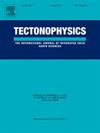基于变质热分析的地质重建及其在活动断层研究中的应用
IF 2.6
3区 地球科学
Q2 GEOCHEMISTRY & GEOPHYSICS
引用次数: 0
摘要
在大断层运动之前重建其周围的地质构造对于理解区域构造和估计断层总位移是至关重要的。通过对周边基底变质岩的变质热分析,重建并验证了日本中部伊藤川-静冈构造线(ISTL)的地质分布。ISTL以南的变质岩热结构表现出两个方向的升温,即地质体西缘自东向西、侵入性深部岩体自南向北。东西向的热结构与ISTL以北的变质岩热结构非常相似。在此基础上,重建的断前构造表明,断裂前,断前构造线南北两侧的断裂暴露的深成体是一个单一的深成体。根据热构造估算和侵入热分析模拟,该区侵入岩浆的范围与重建的深岩体南北跨度一致。这种一致性支持了基于区域热结构重构的有效性。此外,我们的结果与沿ISTL的走滑断裂在岩浆侵入后大约10 Ma发生一致,造成了大约13 km的总水平位移。因此,分析基底岩的变质温度为重建断裂前的地质关系和在地质时间尺度上研究断裂历史提供了一种新颖而有效的方法。本文章由计算机程序翻译,如有差异,请以英文原文为准。
Geological reconstruction based on metamorphic thermal analysis and utility in active fault research
Reconstructing the geological configuration around a major fault prior to its movement is essential for understanding regional tectonics and estimating total fault displacement. We aimed to reconstruct and validate the geological distribution across the Itoigawa–Shizuoka Tectonic Line (ISTL), central Japan, based on a metamorphic thermal analysis of the surrounding basement metamorphic rocks. The thermal structure of metamorphic rocks south of the ISTL shows a temperature increase in two directions: from east to west toward the western margin of the geologic body, and from south to north toward the intruded plutonic body. The east–west thermal structure closely resembles that of the metamorphic rocks north of the ISTL. Based on this regional-scale correspondence in metamorphic thermal structure across the ISTL, the reconstructed pre-faulting configuration suggests that the now discontinuously exposed plutonic bodies to the south and north of the ISTL were originally a single plutonic body before faulting. The extent of the intrusive magma body, inferred from the estimated thermal structure and modeled through intrusion thermal analysis, is consistent with the north–south span of the reconstructed plutonic body. This consistency supports the validity of the reconstruction based on regional thermal structure. Furthermore, our results are consistent with the strike–slip faulting along the ISTL having occurred after the intrusion of magma at approximately 10 Ma and caused a total horizontal displacement of approximately 13 km. Thus, analyzing the metamorphic temperatures of basement rocks offers a novel and effective approach for reconstructing pre-faulting geological relationships and for investigating fault history over geological timescales.
求助全文
通过发布文献求助,成功后即可免费获取论文全文。
去求助
来源期刊

Tectonophysics
地学-地球化学与地球物理
CiteScore
4.90
自引率
6.90%
发文量
300
审稿时长
6 months
期刊介绍:
The prime focus of Tectonophysics will be high-impact original research and reviews in the fields of kinematics, structure, composition, and dynamics of the solid arth at all scales. Tectonophysics particularly encourages submission of papers based on the integration of a multitude of geophysical, geological, geochemical, geodynamic, and geotectonic methods
 求助内容:
求助内容: 应助结果提醒方式:
应助结果提醒方式:


